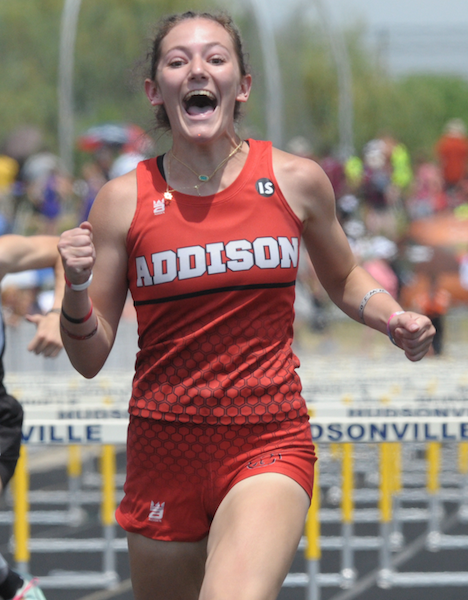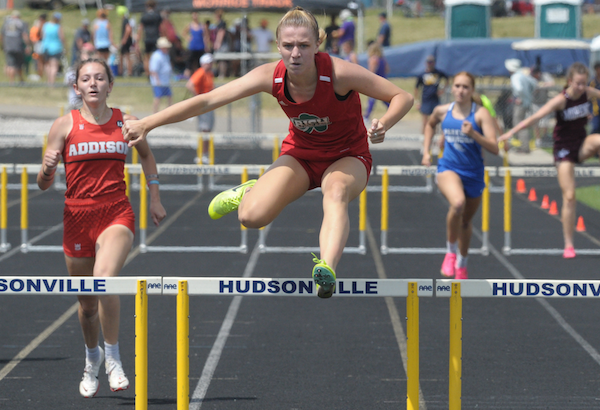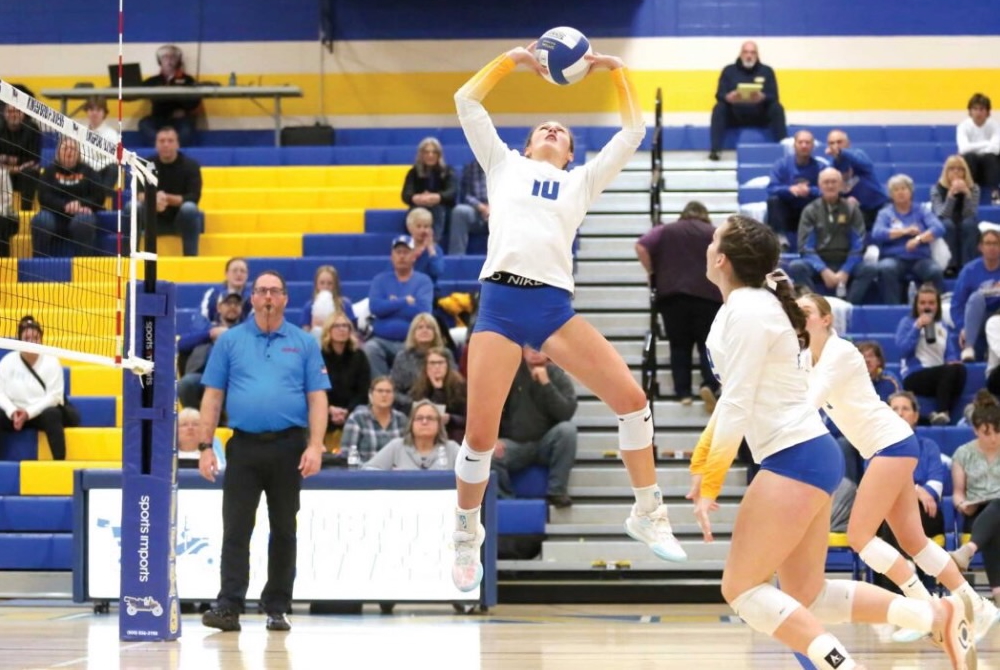
Speedy Sprint-Distance Tandem Carries Buckley to 1st Championship
By
Tom Lang
Special for MHSAA.com
June 3, 2023
HUDSONVILLE – Buckley capitalized on the balance of junior distance star Aiden Harrand and freshman standout sprinter Brooklyn Fraeze to rack up the points needed to win the Lower Peninsula Division 4 track & field championship with 52 points Saturday at Hudsonville.
The team title was Buckley’s first in girls track & field.
Harrand won the 1,600 for the third-consecutive year and added titles in the 800 and the 3,200, leading her team to the championship. Those three wins followed her cross country Finals championship from the fall.
“I think it’s kind of fun,” she said about racking up the titles. “My team motivates me, I mean we’re in it as a group and my points matter, so I do it for them.
 “It was a cool experience to have, winning those two,” she said about the two longest races, the 1,600 and 3,200, which were the hardest of the overall meet due to the low 90s/high 80s heat and searing sun all day. Race officials allowed the unique opportunity for coaches to spray the runners with water and give them water bottles.
“It was a cool experience to have, winning those two,” she said about the two longest races, the 1,600 and 3,200, which were the hardest of the overall meet due to the low 90s/high 80s heat and searing sun all day. Race officials allowed the unique opportunity for coaches to spray the runners with water and give them water bottles.
“The water on the backstretch was so nice, and I’m really glad it was there,” Harrand said about the unusual experience. “My coaches were spraying me, and that was so nice to have.
“And our girls took first overall, so we’re really excited for that. Me and Brooklynn (Fraeze) had lots of points, and our 4 x 400 (eighth place) got us the last points we needed. It was amazing, and this is why we do it.”
Fraeze, a freshman, won 100 dash with a personal best of 12.47. She added a runner-up finish in the 200.
“I was like, oh my gosh I’m doing it, the finish line is right there,” she said about the last 10 meters of the 100, as she finished just ahead of Molly Brown of Addison (12.57).
Brown later won the 100 hurdles.
“The girl who got second place, I felt her at like the halfway point and I was telling myself ‘I’ve got to go,’” Brown said of the hurdles win. “And after I finished the race, I was thinking about it and I heard my family yelling for me. I saw my dad and I started crying; there’s just a lot of emotions.”
Her team finished sixth.
Portland St. Patrick was the team runner-up, just three points back at 49. Indian River Inland Lakes took third, Fowler was fourth and Hillsdale Academy took fifth.
Mount Pleasant Sacred Heart senior Anna Plum successfully defended her 300 hurdles title.
 “I think I was actually seeded third, but I had high expectations since I won last year and I really wanted that again,” Plum said. “It’s kind of like validation.
“I think I was actually seeded third, but I had high expectations since I won last year and I really wanted that again,” Plum said. “It’s kind of like validation.
“We put in great practices, and God, honestly,” she credited as factors for her win and the team’s focus. “We are Sacred Heart and believe in God and put a lot of trust in that.
“My feet are pretty hot right now,” Plum added about the weather conditions. “I bet I’ve got some pretty big blisters. I don’t even know how the 3,200 runners do it. It was insane today.”
Rylee Scheurer led St. Patrick by winning the 200 (25.82), and Natalie Wandrie keyed Inland Lakes’ pursuit with wins in the shot put (39-8) and discus (128-11). Frankfort in the 400 (50.68), Fowler in the 800 (1:47.17) and Hillsdale Academy in the 1,600 (4:08.08) and 3,200 (9:57.73) were relay champions, and Beal City’s Kaylee Locke won the 400 (58.55).
Marlette’s Olivia Findlay won the high jump (5-4) and Wyoming Potter’s House Christian’s Sohanny Gonzalez-Castillo won the long jump (17-4). Deckerville’s Rebecca Moeller was first in the pole vault (10-6).
PHOTOS (Top) Buckley's Aiden Harrand sets the pace in the 1,600 on Saturday. (Middle) Addison's Molly Brown celebrates her win in the 100 hurdles. (Below) Mount Pleasant Sacred Heart's Anna Plum clears a hurdle during the 300. (Photos by Ken Swart/RunMichigan.com.)

Kingsford's Kreider Prepared for Next Level After Finishing Stellar Flivvers Career
By
John Vrancic
Special for MHSAA.com
June 19, 2025
KINGSFORD — After completing a successful high school volleyball career, Maddy Kreider is ready to take the next step.
 The Kingsford senior is taking her talents to Michigan Tech, where she’s expected to continue primarily as a setter.
The Kingsford senior is taking her talents to Michigan Tech, where she’s expected to continue primarily as a setter.
“That will be a big step for sure, but it’ll be exciting being with the girls,” she said. “The girls are taller in college. It will definitely be an adjustment, physically and mentally. We’ll be traveling longer distances, and it’ll be a matter of improving the mental part of my game.”
Kreider was selected the Upper Peninsula’s Defensive Player of the Year her final two seasons after the U.P. Sportswriters and Sportscasters Association began voting for all-U.P. volleyball.
“That’s quite an accomplishment,” she said. “It’s a real honor playing with girls I grew up with. We had a great season.”
The 5-foot-8 setter was a four-year starter and two-year team captain at Kingsford, leading the Flivvers to three Division 2 District titles and back-to-back undefeated Great Northern Conference championships. She twice was named GNC Player of the Year.
She was also selected all-state first team in the fall and all-state second team in 2023, and all-region throughout her prep career. Her serving percentage also topped .900 throughout her four seasons on varsity.
 Last fall, the Flivvers reached the Regional Semifinal at Manistique where they dropped a 3-2 decision to Kingsley.
Last fall, the Flivvers reached the Regional Semifinal at Manistique where they dropped a 3-2 decision to Kingsley.
“I thought we’d get through,” Kreider said. “We came out lights out in the first two sets, then it was close in the last three.”
Also among the team’s highlights this past fall was a victory at Calumet, approximately 2½ weeks after dropping a 3-1 decision to the Copper Kings on Kingsford’s home floor.
“We wanted to play them,” Kreider said. “They’re a great bunch of girls to play against. They’ve been the measuring stick up here for many years. Winning on their floor was super exciting. We knew we had to play well just to be competitive. That was a great confidence builder for our group. We were definitely on a high going into the District.”
The Flivvers opened their postseason with a 3-1 triumph over Houghton, then defeated Escanaba in straight sets in the District Final.
Kreider will join Calumet senior Maddie Torola at MTU this fall. Torola, who recorded a season-high 19 kills in the four-set victory at Kingsford, helped the Copper Kings finish 29-5 and reach the Division 3 Regional Final at Sault Ste. Marie where they dropped a 3-2 decision to Traverse City St. Francis.
“It was fun playing against her in high school,” Kreider said. “It will be even more fun playing as teammates. It’ll be exciting to be playing on the same team.”
Both will be playing under new head coach Cindy Pindral at Tech. Both of Kreider’s parents played for the Huskies, her mother (and Kingsford varsity coach) Jaclynn volleyball from 1998-2002 and her father Jason basketball from 1997-2000.
Maddy Kreider recently earned an additional honor when she was selected Female Athlete of the Year for Kingsford’s Class of 2025. She recently completed a solid track & field season for the Flivvers.
At the U.P. Division 1 Finals, Kreider placed fourth in the 100-meter dash (13.2) and anchored the Flivvers to a third-place finish in the 800 relay (1:51.57) and fourth in the 400 (53.03) on their home track.
Kreider was named one of 32 MHSAA/Farm Bureau Insurance Scholar-Athlete Award winners this winter and plans to study exercise science and kinesiology at MTU.
 John Vrancic has covered high school sports in the Upper Peninsula since joining the Escanaba Daily Press staff in 1985. He is known most prominently across the peninsula for his extensive coverage of cross country and track & field that frequently appears in newspapers from the Wisconsin border to Lake Huron. He received the James Trethewey Award for Distinguished Service in 2015 from the Upper Peninsula Sportswriters and Sportscasters Association.
John Vrancic has covered high school sports in the Upper Peninsula since joining the Escanaba Daily Press staff in 1985. He is known most prominently across the peninsula for his extensive coverage of cross country and track & field that frequently appears in newspapers from the Wisconsin border to Lake Huron. He received the James Trethewey Award for Distinguished Service in 2015 from the Upper Peninsula Sportswriters and Sportscasters Association.
PHOTOS (Top) Kingsford’s Maddy Kreider sets for her teammates during a match last season. (Middle) Kreider, right, takes a photo with Kingsford’s Male Athlete of the Year Gavin Grondin. (Photos provided by the Kingsford athletic department.)

